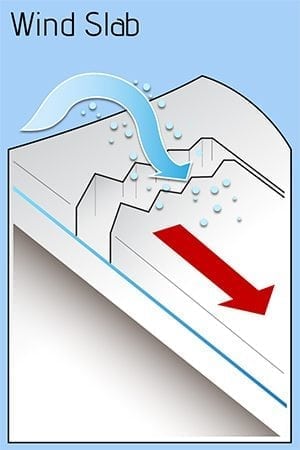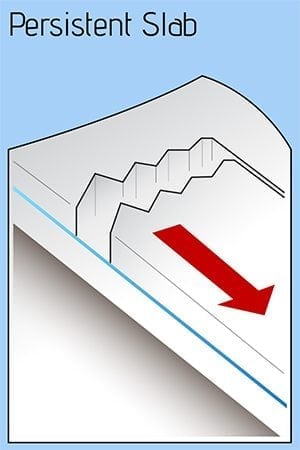Valdez
Above 3,000ftConsiderable
1,500 to 3,000ftConsiderable
Below 1,500ftModerate
Degrees of Avalanche Danger
Avalanche Problems
Problem 1
On 12/2 windslabs 6-12 inches deep were found to be very reactive to a persons weight on lee aspects. The reason for this sensitivity is that new slabs are overlying a weak faceted snowpack in many locations. This will not only cause windslabs to be more reactive to human triggers, but also be reactive for a longer period of time.
Windslabs will continue to become deeper as winds continue 12/3 and are likely already be 2 feet deep in certain locations like lee side of ridge lines or cross loaded gullies. As wind slabs settle and stiffen they may become more stubborn to triggers, but will have the ability to propagate longer distances. Cautious terrain choices and careful terrain management will be necessary today to travel in areas recently affected by wind. Watch for signs of windslab that include hard snow over soft, shooting cracks, collapsing and rounded pillowed snow surfaces. Avoid traveling on large lee slopes steeper than 32°.

Likelihood:
- Almost Certain
- Very Likely
- Likely
- Possible
- Unlikely
Size:
- Historic
- Very Large
- Large
- Small
Trend
- Increasing
- Steady
- Decreasing
Problem 2
The cold and dry weather in November has left us with a weak faceted snowpack. In areas protected from the wind there is 10-20 inches of dry unconsolidated powder. The most important thing to pay attention to at the current time is how stiff or slabby the surface snow is. The stiffer the surface snow is, the higher the likelihood will be for you to trigger an avalanche on terrain steeper than 30°. In areas where the snow surface is dry and unconsolidated (no slab) the stability has been found to be better although structure is still poor, and human triggered avalanches are possible. As snow surfaces stiffen human triggered avalanches become likely. Keep an eye on your partners and only expose one person at a time to avalanche prone slopes.
Don’t expect to find the same snow stability across the forecast area. Re-assess the snowpack every time you are traveling to a new location. Digging snowpits is a good way to asses a snowpack when persistent weak layers exist.
Photo of 1cm+ chained facet found buried 40 cms (16″) on Catchers Mitt 3500′ SE aspect.

Likelihood:
- Almost Certain
- Very Likely
- Likely
- Possible
- Unlikely
Size:
- Historic
- Very Large
- Large
- Small
Trend
- Increasing
- Steady
- Decreasing
Weather
Point forecast for Thompson Pass
Detailed forecast for Thompson Pass (mid elevation 2000-4000′)
DATE FRIDAY 12/03 SATURDAY 12/04
TIME (LT) 06 12 18 00 06 12 18 00 06
CLOUD COVER SC BK SC SC FW SC BK OV OV
CLOUD COVER (%) 45 60 50 45 25 35 65 75 80
TEMPERATURE 6 -1 -5 -5 -3 3 3 3 6
MAX/MIN TEMP 9 -7 6 1
WIND DIR NE NE NE NE NE SE SE SE SE
WIND (MPH) 14 10 9 8 6 5 5 6 6
WIND GUST (MPH) 40 36 35 33 33 32 27 26 25
PRECIP PROB (%) 5 10 5 5 0 10 30 40 60
PRECIP TYPE S S S
12 HOUR QPF 0.00 0.00 0.00 0.04
12 HOUR SNOW 0.0 0.0 0.0 0.0
SNOW LEVEL (KFT)0.0 0.0 0.0 0.0 0.0 0.0 0.0 0.0 0.0
Snow and Temperature Measurements
| Date: 12/03 | 24 hr snow | HN24W* | High Temp | Low Temp | Weekly SWE (Monday- Sunday) | December Snowfall | Season Snowfall | HS (Snowpack depth) |
| Valdez | 4.5 | .24 | 25 | 2 | .54 | 13 | 38 | 18 |
| Thompson Pass | 0 | 0 | 12 | N/O | .9 | 11 | 130 | 30 |
| 46 Mile | 0 | 0 | 17 | -3 | .32 | 5 | 5** | 13
|
All snowfall measurements are expressed in inches and temperature in Fahrenheit. 24 hour sample period is from 6am-6am.
* 24 hour snow water equivalent/ SWE.
** Season total snowfall measurements for 46 mile began December 1st.
Season history graphs for Thompson Pass

Click on links below to see a clear and expanded view of above Season history graphs
Additional Information
Winter weather began early this season, with valley locations receiving their first snowfall on the last day of Summer (September 21st). Following this storm, above average temperatures and wet weather occurred from late September through early November. During this time period Thompson Pass received 96 inches of snowfall by November 7th and Valdez recorded 7.73″ of rain.
After the 7th of November our region experienced a sharp weather pattern change. Temperatures dropped below seasonal norms and snowfall became infrequent. Between the time frame of November 7th- November 28th Thompson Pass only reported 19″ of snow with 1.1″ of Snow water equivalent (SWE). Temperatures remained below 0° F for most of the period. This cold/dry weather caused significant faceting of the snowpack, with poor structure present as of 11/30 in all three forecast zones.
Announcements
Click the + Full Forecast button below for a list of current avalanche problems, travel advice, weather resources and more.
Help to improve your local avalanche center and contribute an observation to the website. You can also contact me directly at ga**********@ya***.com (907)255-7690.

